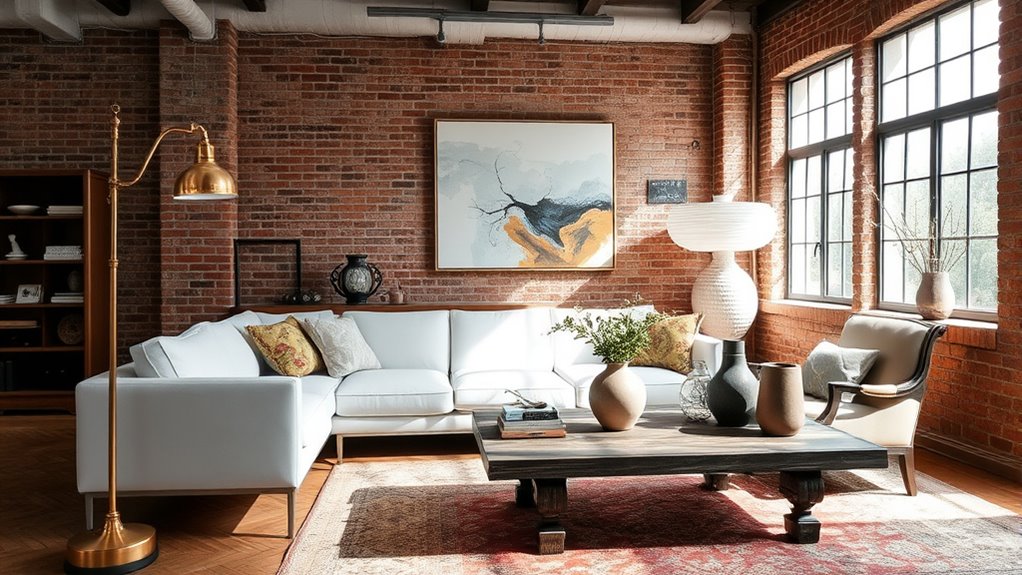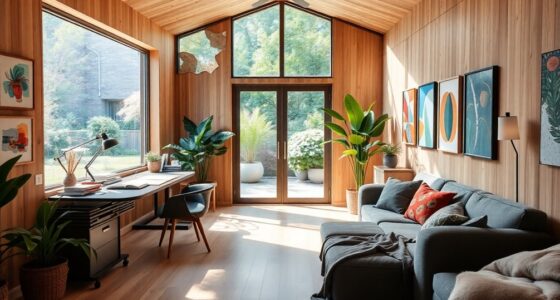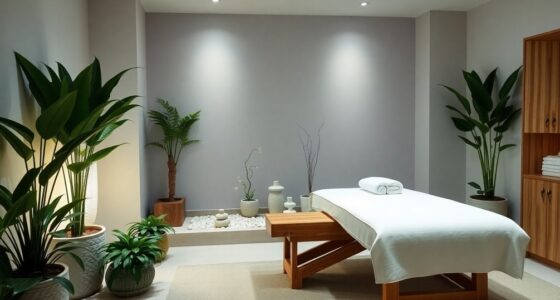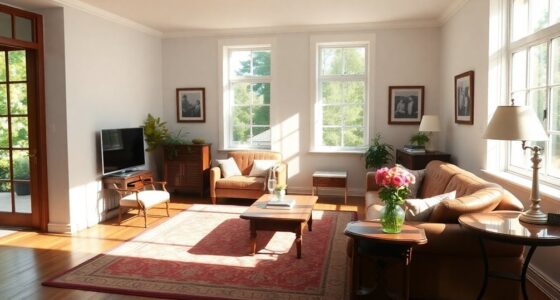To mix vintage and modern styles cohesively, start by establishing a unified color palette with neutral bases and accent tones that highlight vintage pieces while keeping the overall look fresh. Choose a few key items from each era to avoid clutter, balancing scale and visual weight for harmony. Incorporate textures and accessories that blend the old with the new, creating depth and interest. Keep a thoughtful approach, and you’ll craft a stylish, harmonious space—more tips await to help you perfect the balance.
Key Takeaways
- Establish a neutral color palette with whites, grays, or beiges to unify vintage and modern elements seamlessly.
- Select key vintage pieces with distinctive details and balance them with sleek, contemporary decor for contrast.
- Incorporate layered textures and accessories, like textiles and metals, to add depth and cohesion.
- Balance visual weight and scale by distributing large and small items thoughtfully throughout the space.
- Use artwork and accessories to highlight character while maintaining a streamlined, cohesive aesthetic.
Understanding the Distinct Characteristics of Vintage and Modern Styles

To truly appreciate the differences between vintage and modern styles, you need to understand their unique characteristics. Vintage style often features antique furniture, which carries history and craftsmanship, with intricate details and aged finishes that add charm. It’s warm, inviting, and evokes nostalgia. In contrast, modern style emphasizes clean lines, minimalism, and functionality. It favors sleek, often monochromatic or neutral color schemes, complemented by contemporary art that’s bold and abstract. Modern design tends to be less ornate, focusing on open space and simplicity. Recognizing these distinctions helps you see how vintage pieces bring character and history, while modern elements offer a fresh, streamlined look. Understanding self-watering plant pots and their benefits can also inspire how you incorporate functional, stylish elements into your space. Combining them thoughtfully can create a dynamic, balanced space that reflects both the past and present.
Establishing a Cohesive Color Palette and Theme
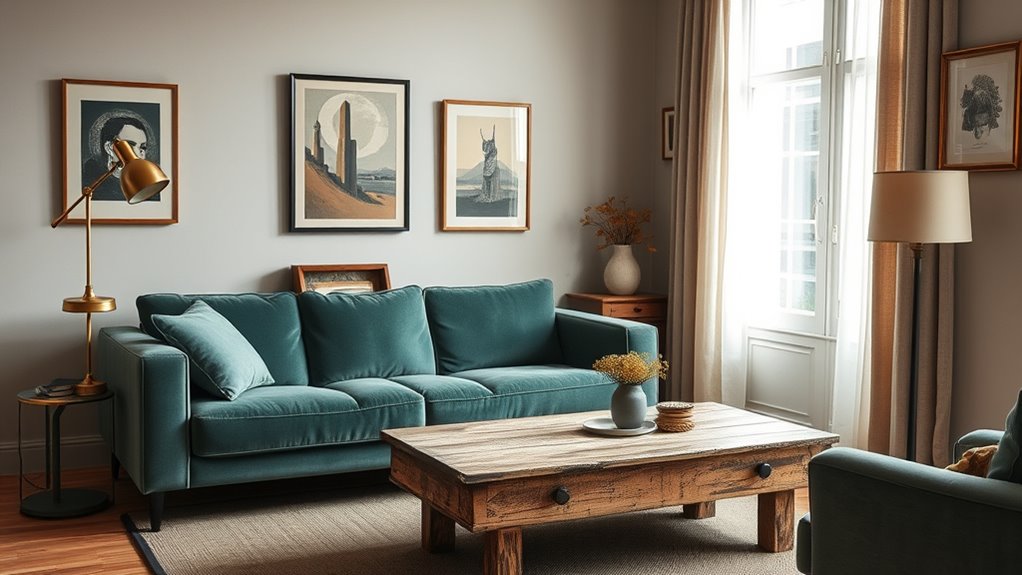
Creating a cohesive color palette and theme is essential for blending vintage and modern styles seamlessly. You want to focus on color matching to guarantee shades complement each other, rather than clash. Start by choosing a neutral base that ties both eras together, such as whites, grays, or beiges. Then, incorporate accent colors that reflect your vintage pieces while maintaining a modern vibe. Consistent theme elements, like patterns or textures, help reinforce theme consistency. Avoid mixing too many bold or contrasting colors, which can disrupt harmony. Instead, select a unified color scheme that highlights the unique charm of each style without overwhelming the space. A well-planned palette creates visual balance, making vintage and modern elements feel intentional and cohesive. Incorporating vintage decor thoughtfully can further enhance this harmony by adding character without disrupting the overall aesthetic.
Selecting the Right Pieces to Highlight Each Era

Choosing the right pieces to highlight each era is essential for creating a balanced vintage-modern mix. Select antique furniture with distinctive lines or details that showcase its era, making it a focal point. Incorporate contemporary art pieces that contrast or complement these antiques, adding a modern touch. To help visualize, consider this table:
| Vintage Pieces | Modern Elements | Highlighted Features |
|---|---|---|
| Ornate antique furniture | Sleek contemporary sculptures | Balance between ornate and minimal |
| Vintage textiles | Abstract wall art | Texture contrast |
| Classic lighting fixtures | Modern pendant lamps | Mixing old-world charm with current trends |
Focus on highlighting one or two key items from each era, ensuring they stand out without overwhelming the space. Additionally, understanding design trends can help you select pieces that will remain timeless while blending vintage and modern styles seamlessly.
Balancing Visual Weight and Scale for Harmony
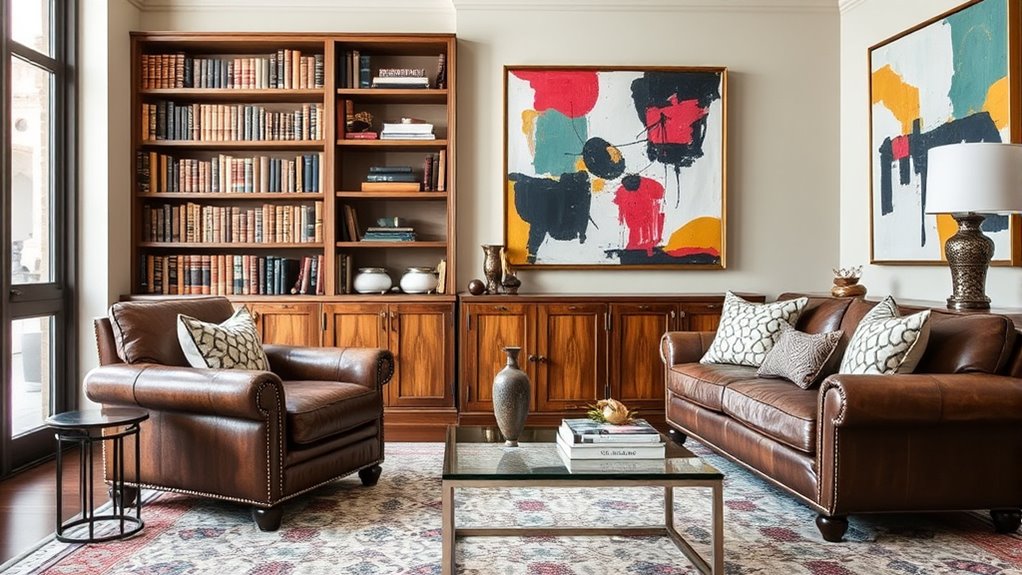
Once you’ve selected the key vintage and modern pieces to showcase, the next step is to arrange them in a way that achieves visual harmony. Focus on creating proportional balance by varying the sizes and weights of your items, ensuring no single piece overwhelms the space. Larger, statement pieces should be balanced with smaller, complementary items to maintain equilibrium. Pay attention to spatial harmony—distributing objects thoughtfully across the room so that each element feels connected yet balanced. Avoid clustering items too tightly or leaving large gaps; instead, aim for a cohesive flow that guides the eye smoothly. Additionally, considering how insulation and air circulation impact the overall environment can help inform your placement choices to enhance the room’s comfort and aesthetic. By carefully balancing scale and visual weight, you’ll create a space that feels both dynamic and unified, seamlessly blending vintage charm with modern sophistication.
Incorporating Accessories and Textures to Tie the Look Together
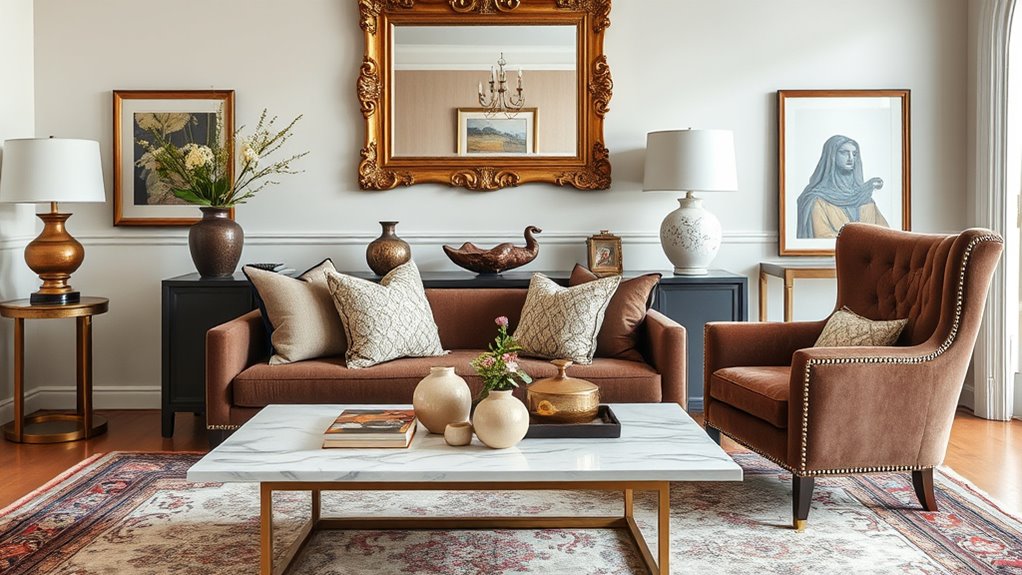
To seamlessly tie vintage and modern elements together, incorporating the right accessories and textures is essential. Layering textures adds depth and interest, helping different styles blend effortlessly. Combine smooth, sleek fabrics with rougher textiles like knits or leather to create visual contrast. Choosing statement accessories, such as bold jewelry or vintage-inspired bags, anchors your look and draws attention to your curated style. Mix modern minimalist pieces with vintage finds to strike a balanced aesthetic. Remember, subtle touches can unify diverse elements—think textured throw pillows, layered rugs, or contrasting metals in your jewelry. Additionally, incorporating AI-powered virtual reality can help visualize how different textures and accessories will look together before committing to the full ensemble. By intentionally layering textures and selecting standout accessories, you create a cohesive look that feels intentional, stylish, and uniquely yours.
Frequently Asked Questions
How Can I Blend Vintage and Modern Furniture Without Clashing?
When blending vintage and modern furniture, you want to focus on color coordination and furniture proportions. Choose a neutral or cohesive color palette to unify different styles, and balance the proportions so pieces complement each other without overwhelming the space. Incorporate statement vintage pieces with sleek modern accents, ensuring they don’t clash. This approach creates a harmonious look where both styles enhance each other naturally.
What Are the Best Lighting Options for Mixed-Era Interiors?
You should focus on lighting trends that complement both vintage and modern styles. Opt for fixture selection that balances old and new, like combining sleek, minimalist fixtures with vintage-inspired chandeliers. Use warm light bulbs to enhance the cozy vintage feel, while incorporating modern fixtures with clean lines for contrast. Mix and match different eras thoughtfully, ensuring your lighting enhances the overall harmony rather than clashing.
How Do I Update Vintage Pieces for a Contemporary Look?
Ever wonder how to give your vintage pieces a fresh, modern vibe? You can achieve this through antique restoration and smart modernization techniques, like updating hardware or repainting with contemporary colors. Why not keep the charm but add sleek, new elements? By blending old-world craftsmanship with modern touches, you create a cohesive look that feels both timeless and current. It’s all about balancing history with today’s style.
Can Mixing Eras Work in Small Spaces Effectively?
In small spaces, mixing eras can work effectively if you focus on space optimization and color coordination. You’ll want to choose vintage pieces that don’t overpower the room, pairing them with modern elements to create balance. Use a consistent color palette to tie everything together, making the space feel cohesive rather than cluttered. With thoughtful placement and thoughtful selection, you can seamlessly blend styles to maximize your small space’s potential.
What Are Common Mistakes to Avoid When Combining Vintage and Modern Styles?
When combining vintage and modern styles, avoid common mistakes that disrupt style harmony. Don’t overlook color coordination; clashing hues can make the space feel chaotic. Also, steer clear of overwhelming the room with too many contrasting elements. Instead, balance vintage pieces with sleek modern furniture, and choose a unifying color palette. This approach ensures your space feels cohesive, stylish, and inviting without one style overpowering the other.
Conclusion
Think of blending vintage and modern styles like mixing colors on a palette—you want the hues to complement, not clash. When I first dared to combine a sleek sofa with retro accessories, it felt like blending two melodies into a harmonious song. With patience and attention to balance, you’ll create a space that’s uniquely yours—vintage charm meeting modern flair, crafting a masterpiece that’s both timeless and fresh. Trust your instincts, and let your style sing.
